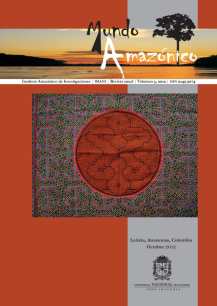Forced migration and indigenous knowledge of displaced Emberá and Uitoto populations in Colombia: An ethnobotanical perspective
Palabras clave:
Caquetá, handicrafts, medicinal plants, Northwestern Amazonia, seeds, violence, Uitoto, Embera (en)Amazonia noroccidental, artesanías, Caquetá, plantas medicinales, semillas, violencia, uitoto, embera (es)
Descargas
Relatively little attention has been given to documenting changes in the ethnobotanical knowledge of displaced indigenous groups in Colombia. Such information is highly valuable because it contributes to our understanding of the changes that occur during this process of displacement, cultural transformation and loss, and because it eventually could shed some light in designing social, economic, and educational policies that would facilitate their incorporation into main stream culture, through ways that validate their indigenous identity, knowledge, and traditions. Based on our on-going research, herein we summarize ethnobotanical information of two indigenous groups currently residing in the city of Florencia (capital of the Department of Caquetá) in the Northwestern Amazon basin: the Emberá, originally from northwestern Colombia, and Uitoto, originally from the Colombian Amazon. By focusing in the indigenous ethnobotanical knowledge of these two displaced groups, we intend to show the revitalization of ethnobotanical knowledge, resilience, and multiple resources in form of ancestral knowledge that are brought and transmitted by these groups as they struggle for survival, in many times hostile urban environments. We hope to draw more attention to and encourage similar studies on other displaced indigenous populations in Colombia as well as in other areas of Latin America.
Relatively little attention has been given to documenting changes in the ethnobotanical knowledge of displaced indigenous groups in Colombia. Such information is highly valuable because it contributes to our understanding of the changes that occur during this process of displacement, cultural transformation and loss, and because it eventually could shed some light in designing social, economic, and educational policies that would facilitate their incorporation into main stream culture, through ways that validate their indigenous identity, knowledge, and traditions. Based on our on-going research, herein we summarize ethnobotanical information of two indigenous groups currently residing in the city of Florencia (capital of the Department of Caquetá) in the Northwestern Amazon basin: the Emberá, originally from northwestern Colombia, and Uitoto, originally from the Colombian Amazon. By focusing in the indigenous ethnobotanical knowledge of these two displaced groups, we intend to show the revitalization of ethnobotanical knowledge, resilience, and multiple resources in form of ancestral knowledge that are brought and transmitted by these groups as they struggle for survival, in many times hostile urban environments. We hope to draw more attention to and encourage similar studies on other displaced indigenous populations in Colombia as well as in other areas of Latin America.
Migración forzada y conocimiento indígena de poblaciones desplazadas emberá y uitoto en Colombia: una perspectiva etnobotánica
Relativamente poca atención se le ha dado a documentar los cambios en el conocimiento etnobotánico de los grupos indígenas desplazados en Colombia. Esta información es muy valiosa porque contribuye a entender los cambios que ocurren durante este proceso de desplazamiento, transformación y pérdida cultural, y porque eventualmente podría ayudarnos en el diseño de políticas sociales, económicas y educativas que faciliten la incorporación de estas comunidades a la cultura mestiza occidental, a través de formas que validen su identidad indígena, conocimiento y tradiciones. A partir de nuestras investigaciones en curso, en ese documento resumimos la información botánica de dos grupos indígenas que actualmente viven en la ciudad de Florencia (capital del Departamento del Caquetá) en la cuenca amazónica noroccidental: Los emberá, originalmente ubicados en el noroccidente de Colombia, y los uitoto, originalmente ubicados en la Amazonia colombiana. Al enfocarnos en el conocimiento indígena de estos grupos, tenemos la intención de mostrar la revitalización del conocimiento etnobotánico, resistencia y múltiples recursos en forma de conocimientos ancestrales que son transmitidos y conservados por estos grupos en su lucha por la supervivencia, en muchas ocasiones en entornos urbanos hostiles. Esperamos que este trabajo promueva estudios similares en otras poblaciones indígenas desplazadas en Colombia y en Latinoamérica.
Cómo citar
APA
ACM
ACS
ABNT
Chicago
Harvard
IEEE
MLA
Turabian
Vancouver
Descargar cita
Visitas a la página del resumen del artículo
Descargas
Licencia
Derechos de autor 2015 Victor Hugo Gonzalez Betancourt, Patricio Ortiz, Gina Frausin

Esta obra está bajo una licencia internacional Creative Commons Atribución-NoComercial-SinDerivadas 4.0.
Los autores son responsables de todas las autorizaciones que la publicación de sus contribuciones pueda requerir. Cuando el manuscrito sea aceptado para publicación, los autores deberán enviar una declaración formal sobre la autenticidad del trabajo, asumiendo personalmente la responsabilidad por todo lo que el artículo contenga e indicando expresamente su derecho a editarlo. La publicación de un artículo en Mundo Amazónico no implica la cesión de derechos por parte de sus autores; sin embargo, el envío de la contribución representa autorización de los autores a Mundo Amazónico para su publicación. En caso de realizarse una reimpresión total o parcial de un artículo publicado en Mundo Amazónico, ya sea en su idioma original o en una versión traducida, se debe citar la fuente original. Los artículos publicados en la revista están amparados por una licencia Creative Commons 4.0.
Los autores que publican en esta revista están de acuerdo con los siguientes términos:
- Los autores conservan el copyright y otorgan a la revista el derecho de la primera publicación, con el trabajo simultáneamente licenciado bajo una Creative Commons Attribution License que permite a otros compartir el trabajo con el reconocimiento de la autoría y la publicación inicial en esta revista.
- Los autores pueden hacer arreglos contractuales adicionales para la distribución no-exclusiva de la versión publicada en la revista (por ejemplo, colocar en un repositorio institucional o publicarlo en un libro), con el reconocimiento de su publicación inicial en esta revista.

















